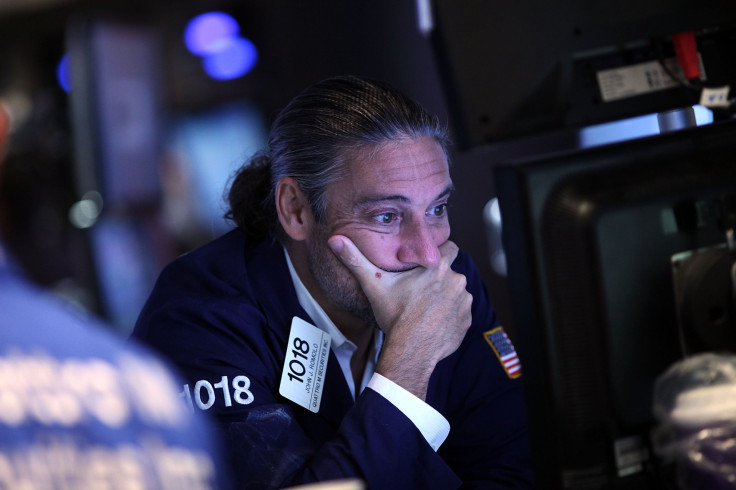Dow Jones Industrial Average Plummets, Global Stocks Take 'Black Monday' Plunge On 'Great Fall Of China'

U.S stocks recovered Monday from some of the morning's mayhem that saw the Dow Jones Industrial Average plummet more than 1,000 points in the first four minutes of trading. By the close, the Dow was down just 588 points. The day's volatile trading session followed a global stock sell-off across European and Asian markets as investors react to heightened fears that China’s economy is slowing at a rapid pace. All three major indexes saw their worst opens since the financial crisis of 2008.
By afternoon, stocks had begun to pare losses from earlier in the day, as traders found scattered bargains amid the rubble.
“What’s happening is hedge funds, program traders and, to a much lesser degree, institutional investors that are playing a significant role in the market ... ," said Tony Roth, chief investment officer at Wilmington Trust. “You’ve got players trying to make money on very short-term swings in the market.”
More broadly, however, U.S. investors are worried that China's deceleration will infect emerging market economies and the U.S. "China accounts for more than 15 percent of the world’s growth, so if they slow down it’s a problem, especially emerging markets," said Alan Valdes, vice president of trading at DME Securities. "Emerging markets buy a lot of goods from the U.S., and if you see those countries continue to get hit, that will spill over to U.S. multinationals, which could lead to job layoffs here in the States."
The CBOE Volatility Index, also known as the VIX, spiked as much as 90 percent to 53 following Monday's opening bell. The last time the index jumped above 50 was in March 2009.
“The volatility in this market is something we’ve never seen before,” said Jonathan Corpina, senior managing partner with Meridian Equity Partners. "We’re a global market and a global economy. Everything is intertwined, so investors fear if one domino falls, then what’s the rippling effect going to be."
The sharp U.S. stock downturn was anticipated after futures pointed to Monday mayhem. Dow futures plunged more than 800 points before the U.S. markets opened, as fears of a major Chinese economic downturn escalated across global markets. European markets extended losses in afternoon trading Monday, with the pan-European Stoxx 600 index down nearly 5 percent. Japan’s Nikkei 225 index dropped 4.6 percent to finish at its lowest closing level since Feb. 23. China’s benchmark Shanghai composite recorded its biggest one-day percentage loss since 2007, closing down 8.5 percent, in a performance dubbed “Black Monday” by China’s state media.
The Dow Jones Industrial Average (INDEXDJX:.DJI) was down 588.47 points, or 3.58 percent, to 15,871.28. The Standard & Poor's 500 index (INDEXSP:.INX) fell 77.66 points, or 3.94 percent, to 1,893.23. And the Nasdaq composite (INDEXNASDAQ:.IXIC) fell 179.79 points, or 3.82 percent, to 4,526.25.
The stock rout first began Friday with China's posting of numbers that showed factory production in the world’s second-largest economy shrank in August at its fastest rate in more than six years. The numbers fuel concerns that China’s sudden slowing will have far-reaching effects around the world.
All four major indices, including the Dow, S&P 500, Nasdaq and Russell 2000, finished the day at least 3.5 percent lower.
All 10 sectors in the S&P 500 traded lower, led by declines in energy and bank stocks. Basic materials and consumer discretionary stocks dropped more than 4 percent on Monday. The best performing sector for the day was telecommunications, surrendering 3.1 percent.
Meanwhile, all 30 stocks in the Dow traded sharply lower, led by a 5.27 percent decline from JPMorgan Chase & Co. (NYSE:JPM), while Cisco Systems Inc. (NASDAQ:CSCO) and Chevron Corporation (NYSE:CVX) lost 4.42 percent and 4.82 percent, respectively.
The yield on the U.S. 10-year Treasury slid further Monday to 2.01 percent from 2.045 percent Friday, but did edge mildly higher after falling below 2 percent in morning trading amid growing uncertainty about global economic growth. When investor confidence is low, the price on the 10-year goes up as there is more demand for Treasurys as a safe investment, and yields subsequently fall.
The U.S. dollar fell against major currencies amid growing uncertainty of whether the U.S. Federal Reserve may wait even longer than planned to raise interest rates. A rate hike was being anticipated for September.
U.S. oil prices extended losses Monday, tumbling 4 percent to trade below $40 after tallying an eighth straight weekly decline last week, the longest weekly losing streak in nearly 30 years. This marked its lowest level since February 2009, with U.S. crude down around nearly 60 percent in the last 12 months.
West Texas Intermediate crude, the benchmark for U.S. oil prices, fell 5.5 percent to $38.24 per barrel for October delivery on the New York Mercantile Exchange. On the London ICE Futures Exchange, Brent crude, the global benchmark for oil prices, dropped 6 percent to $42.80.
© Copyright IBTimes 2024. All rights reserved.






















